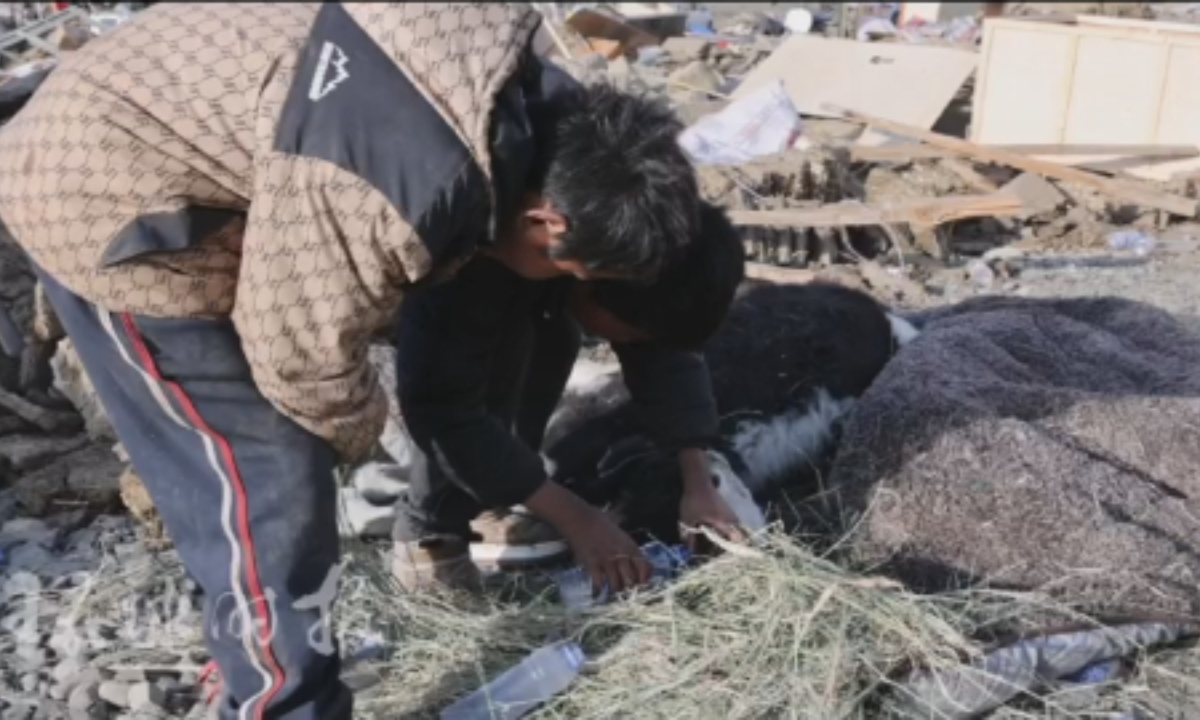
A boy from Gurum Village in Chamco Township of Dingri County in Xigaze, Southwest China's Xizang Autonomous Region, together with his friend from the same village, saves a yak. Photo: Fan Wei
Tenzin is a 14-year-old boy from Gurum Village in Chamco Township of Dingri County in Xigaze, Southwest China's Xizang Autonomous Region. Following the 6.8 magnitude earthquake that hit Dingri, Tenzin sustained a minor head injury. After being sent to the hospital for emergency treatment, he quickly reunited with his parents. On his way back to the temporary resettlement site in the village, Tenzin noticed a yak that had been unearthed from the rubble of a collapsed building and seemed to have a chance of survival. Together with his 12-year-old friend from the same village, Kunga Tsering, they began to save the yak.
On the way to the village on Monday, the Global Times reporter observed the two boys feeding grass and water to the severely injured yak by the roadside. The boys told the Global Times that they had discovered the yak two days earlier and started trying to rescue and take care of it. However, despite their efforts, they found the yak's injuries were extremely severe, leaving it with little chance of survival. Even so, they refused to give up, continuing to feed it grass and water on schedule.
"If we don't feed it, it will starve to death," the two boys told the Global Times. Although the yak is not theirs and it is unlikely to survive, they still wanted to help it.
In the earthquake-affected areas of Dingri County, the Global Times observed that livestock, such as yaks, as part of the affected residents' property, have also been a focus of rescue efforts by emergency response teams amid the disaster. Dead livestock retrieved from collapsed buildings have also been professionally handled by epidemic prevention teams.
The Global Times learned that following the earthquake, the Animal Disease Control Center of the Bureau of Agriculture and Rural Affairs in Xigaze city immediately deployed personnel to the disaster-stricken areas. Their routine tasks include carrying out the safe disposal of dead livestock carcasses.
"This work can effectively eliminate the source of animal epidemic transmission and prevent the occurrence of major animal diseases and zoonoses. As long as we find the carcasses of livestock, we will conduct burying or other harmless disposal measures. This ensures the healthy development of the livestock industry and public health safety," Tseten Ngodrup, director of the center, to the Global Times.
During the rescue and cleanup operations, the rescue teams would make every effort to minimize the economic losses of the affected residents, and that healthy livestock discovered would be returned to their owners. Severely injured animals beyond saving, found during cleanup operations, would be dealt with according to the owners' wishes and local customs, with harmless disposal carried out after the livestock had died, he said.




